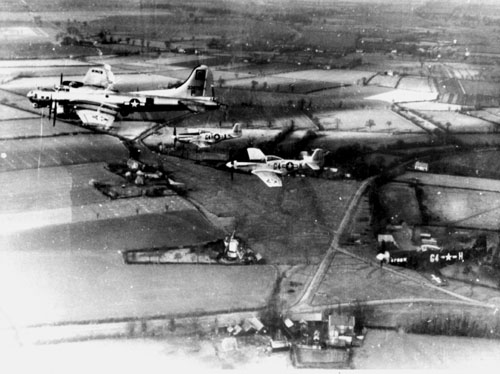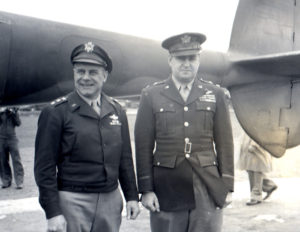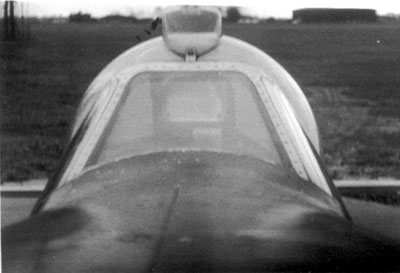
Mustangs of the 362nd FS escort a B-17. Photo Merle Olmsted
Air War Over Europe
Selected excerpts from Scott Richardson’s Thesis “A History of the Eighth Air Force Fighter Operations 1942 to 1945.”
In early 1944 an event of historic importance took place – the release of fighters from the close escort policy and the establishment of a relay escort pattern. General James H. Doolittle replaced General Eaker as head of the Eighth Air Force on 5 January 1944. Doolittle was a fighter pilot at heart and understood the frustrations caused by the close escort policy. He often came to Fighter Command operations and listened to the radio chatter of his fighter pilots in combat. Sitting in a chair with eyes closed and ear phones on, he stayed until the last of his fighter pilots returned to their bases.
Doolittle changed the close escort policy after his arrival when he ordered General Kepner to “flush them (Luftwaffe fighter aircraft) out in the air and beat them up on the ground on the way home. Your first priority is to take the offensive.” He told Kepner to tear down a sign posted in Eighth Fighter Command Headquarters that read “THE FIRST DUTY OF THE EIGHTH AIR FORCE FIGHTERS IS TO BRING THE BOMBERS BACK ALIVE” and replace it with one that read ” THE FIRST DUTY OF THE EIGHTH AIR FORCE FIGHTERS IS TO DESTROY GERMAN FIGHTERS.” General Kepner was overjoyed at this order and tore the sign down as Doolittle walked out the door.

Lt. Gen. Jimmy Doolittle. Commander 8th Air Force (left) with Maj. Gen. Curtis LeMay (right), standing between tail booms of a Lockheed P-38 Lightning in Britain, 1944
The death of the close escort policy resulted in a modification of the relay system. Instead of flying to a rendezvous point, Eighth fighter groups now patrolled predetermined areas along the bomber’s route to the target. Thunderbolts groups patrolled the shallow and medium range distances with the most experienced groups flying where enemy opposition was expected. Target area support was assigned to the P-38s and P-51s because of their long range.
Lightning groups took over escort from the P-47s and handed the bombers over to the Mustang groups about 100-150 miles from the target. Major Thomas Hayes of the 357th Fighter Group remembers his group: “…provided area support ahead of the bombers and five to ten miles laterally. The group leader would continue ahead of the bombers plus or minus thirty to forty miles with a squadron on each side, the high squadron usually on the right side, then execute a 180 degree turn in a race track pattern bringing the group over the lead bomber to repeat the pattern.”
The North American P-51 Mustang was designed, built, and flown in 102 days. It languished on RAF and USAAF air fields as a result of being under powered until the British put a Rolls Royce Merlin engine in the air frame. The results were dramatic, transforming the once scorned Mustang into the best overall fighter of the war. Carrying four fifty caliber machine-guns in the B Model and six fifty caliber machine guns in the D Model, the Mustang was equal to the Me 109 in maneuverability and more maneuverable than the FW 190. It had a top speed of 445 mile per hour at 24,000 feet and a service ceiling of 40,000 feet. “Traffic pattern air speeds were 115 to 120 miles per hour on final approach with touch down around 100 to 90 miles per hour.” A low fuel consumption rate of one gallon a minute at cruise speed, combined with a fuel capacity of 485 gallons allowed Mustang pilots to fly to any target within 2,120 miles from base.
Another piece of equipment that gave the Eighth fighter pilot an advantage over his Luftwaffe counterpart was the G-suit. Standard flight gear of an American fighter pilot consisted of a helmet, sloping goggles, a white silk scarf, a gabardine flight suit, an A-2 leather jacket, leather gloves, and fur lined boots. This outfit kept the pilot warm at high altitude, but failed to keep the pilot from blacking out during high-G maneuvers. The G-suit was designed to solve this problem.
Two types of G-suits were tested by Eighth fighter groups. The British suit used water and was tested by the 357th, while the 4th Fighter Group tested the American design that used air. the British suit, known as the “Frank suite,” resembled fishing waders. It was made of rubber and came up to the pilots armpits. Major Thomas Hayes remembers, “…the suit was very stiff and cumbersome and the ground crew filled it with water while the pilot stood. Once filled, the ground crew helped the pilot into the cockpit. Cumbersome as it was, the suit was effective in delaying the black outs. However, the 357th did not think the tradeoff was worth the fatigue on the pilot.”
The American suit, know as the “Berger suit,” had a tight fitting band around each calf and thigh as well as the stomach. It was pressurized from the positive side of the vacuum pump through a valve that opened when the pilot experienced G-load maneuvers. The suit, when pressurized, tightened up and squeezed the pilot so the blood did not drain from his brain and cause a black out. Eighth fighter pilots agreed the Berger suit was superior to the Frank suit and were equipped with the American version during the summer.

Looking in the wind screen of a P-51D. Photo Will Foard
A second development arrived later in the summer of 1944 in the form of a new gun sight. Eighth fighter aircraft were equipped with a fixed sight, called the N-3 and later N-9 gun sight,. Both sights were optical with a ring and dot of light called the “pipper,” which projected onto the clear glass in front of the sight. The pilot looked at his target through the gun sight, putting the pipper on the target only when there was no angle off involved, which is from directly ahead or directly behind. To make a deflection shot, he estimated the angle off to the target and then placed the pipper ahead to get proper lead.
The new K-14 gyroscopic gun sight solved this problem for the pilot. the pilot used the k-14 much like the N-3 or N-9, but with a few exceptions. The K-14 had a dial attached to the throttle, which enabled the pilot to set a ring of diamonds around the target’s wing span. Once the target’s wing span was selected, the pilot placed the ring and pipper on the aircraft and maneuvered his fighter to keep the target centered for a brief second. The K-14 computed the range and angle of the target in relation to the attacking fighter, and moved the pipper to the proper aim point. The fighter pilot then moved the nose of his aircraft to center the pipper. Once this was accomplished, he could open fire on the target.
The K-14 was not too popular at first, due to its mounting in the cockpit. Mounted right on top of the instrument panel, the new gun sight extended back to within inches of the pilot’s face. this blocked the pilot’s vision and created a serious hazard if he was forced to belly land his fighter. This problem was solved by a sergeant in the 357th Fighter Group.
Sergeant Idalo E. Auguliaro solved the problem by cutting a hoe out of the glare shield and moving the sight forward. The group’s pilots were pleased with this modification and sent the specifications to the Air Corps engineering center at Wright Field in Dayton, Ohio. The engineering center rejected the improvement and ordered the 357th to place the sight back in it’s original position. The Yoxford Boys ignored the order, remounted the rest of their sights in the same fashion, and shared their discovery with the rest of the Mustang equipped groups., This resulted the the North American factory retooling their assembly line to mount the gun sight as the 357th had discovered. Sergeant Auguliaro received the Bronze Star for his efforts.
*Strafing airfields was particularly dangerous due to the numerous antiaircraft guns. German flak-towers lined the fields and were usually the first guns attacked by strafing aircraft. A flak tower consisted of a concrete pillar sixteen to twenty feet high with a circular platform mounted on top. the platform averaged six feet in diameter and had a five foot wall. Usually, these towers had a twenty millimeter or forty millimeter gun mounted on top.
Because of the placement of these flak-towers, no two strafing attacks were the same. Ideally, Eighth fighter pilots would fly high over the field as if they had o interest in the target below. The would pick out landmarks to help them line up their attack run and then dive to tree top level. Racing along at 400 miles per hour, they would pop up over the trees, line up on gun emplacements or aircraft, and open fire,. The first wave usually caught Luftwaffe ground personnel and antiaircraft gunners by surprise, while the succeeding waves of strafing aircraft flew through a hail storm of antiaircraft fire. Several leading Eighth Air Force pilots would become prisoners of war as a result of ground fire.
Conclusion:
The vital role Eighth Air Force fighter pilots played in defeating Nazi Germany extended beyond protecting the bombers. Descending to tree top altitude, Eighth fighter pilots severely hampered the German transportation system by strafing locomotives, rolling stock, barges and road vehicles. These marauding fighter aircraft also destroyed large numbers of German transport aircraft in addition to the bombers and fighters parked on air fields and by the side of the rode.
The fighter-bomber capability enabled Eighth fighter pilots to play a tactical role on or behind the battlefield by blasting enemy strongholds, supply dumps, tanks, troop concentrations, and gun emplacements. Their ground attack capability enabled them to isolate the enemy by destroying bridges, tunnel entrances, and crossroads.
Eighth fighter pilots also played havoc with the Luftwaffe’s pilot training program. Young, inexperienced pilots soon found themselves unable to learn the basic fundamentals of flying without interference from Eighth fighter pilots, As a result, new Luftwaffe pilots failed to get the experience they needed before being posted to operational fighter units. This had the effect of weakening Luftwaffe fighter units, which also weakened the ferocity of their attacks on B-17s and B-24s.
Eighth Air Force fighter pilots were the reason for the bomber’s success. Their presence provided security to the bombers, and torment to Luftwaffe fighter pilots. Without the presence of the Eighth fighter pilot, Luftwaffe forces could possibly have stopped the daylight strategic bombing campaign just as they had done against the RAF.
The Eighth’s fighter pilots forced Luftwaffe commanders to transfer desperately needed day fighter units from the Eastern and Mediterranean fronts. This had a detrimental effect, especially on the Eastern Front, where Luftwaffe fighter pilots were out numbered two to one at the Battle of Kursk in early July 1943. History records the engagement at Kursk as the largest tank battle of the Second World War, but fails to mention it marked the decline of the Luftwaffe fighter strength on the Eastern Front. Eighth fighter pilots were not deterred by the increased strength of Luftwaffe day fighter units in Germany and the Western Front in 1943. In stead, they threw themselves at the enemy, and not only won air superiority, but achieved air supremacy.
This supremacy removed the threat of the Luftwaffe’s ground attack capability. Therefore, Eighth fighter pilots helped the Normandy invasion to succeed on 6 June 1944., because of their operations during the previous twenty-two months. Without them, a healthy German Air Force could possibly have repulsed the Normandy invasion. This point was acknowledged by General Eisenhower, a week after the successful invasion, when his son pointed out the vehicles moving bumper to bumper from the landing craft to the roads violated West Point textbook doctrine. “You’d never get away with this if you didn’t have air supremacy,” remarked Second Lieutenant John Eisenhower. His dad replied, “If I didn’t have air supremacy, I wouldn’t be here.”
There is no question of the important role Eighth fighter pilots played for the heavy bomber crews. Bomber crews loved their “Little Friends” and hated to fly any mission without them. This love and admiration persists fifty-one years later, when a B-24 crewman wrote the author, “Little Friend, My Friend. One of the prettiest sights I ever saw was the P-51, the P-47, or the P-38 flying with our group., I still say an occasional prayer for those fighter pilots.”

